Apps
Auto Added by WPeMatico
Auto Added by WPeMatico
Netflix is ready to take its lower-cost, mobile-only plan beyond India as it looks to expand the reach of its service in other international markets. The American on-demand video streaming giant today launched a new price tier in Malaysia that will allow people in the nation to access the video service for RM 17 ($4) a month.
The new tier, which is being offered alongside existing regular monthly plans that start from $7.8, limits access to Netflix to just one mobile device and in lower video quality (standard definition, ~480p). (Customers subscribed to this plan are not allowed to watch — or cast — Netflix on their TVs and laptops.)
The company, which began testing cheaper mobile plans last year in many markets, including Malaysia, said it is hopeful that its new plan would “broaden access to Netflix in this truly mobile-first nation.”
More than 88% of people in Malaysia own a smartphone and 78% of internet users in the Southeast Asian nation — home to roughly 32 million people — stream and download media content, according to industry estimates.
In a statement, Ajay Arora, director of Product Innovation at Netflix, said, “our members in Malaysia love to watch shows on their smartphones and tablets. With the first-ever Mobile plan in Southeast Asia, all of Netflix’s shows and movies will be even more accessible for Malaysians to stream and download.”
Like in India, Netflix competes with a range of aggressively priced services in Malaysia, such as iFlix, Dimsum, playTV and Astro Go. And like in other markets, the company has invested in production of original content to better serve customers in Malaysia, too. Upcoming series “The Ghost Bride” was filmed and produced in Malaysia. Comedy series “Polis Evo” and “Jagat” have also been popular among customers in the nation.
As we have argued in the past, Netflix’s standard pricing has limited its reach in many parts of the world, especially because a number of rivals are offering their services at lower cost. On its part, Netflix is increasingly admitting this publicly. During its quarterly earnings call last week, the company executives noted that it was “pleased” with the way its $2.8 monthly mobile-only plan in India was gaining adoption.
“Our approach with pricing is to grow revenue and so far, uptake and retention on our mobile plan in India has been better than our initial testing suggested. This will allow us to invest more in Indian content to further satisfy our members. While still only a very small percentage of our total subscriber base, we’re continuing to test mobile-only plans in other markets,” they said.
Greg Peters, chief product officer at Netflix, said the company continues to explore more plan structures and “feature value benefits” in other markets to see how the audiences react to them. In some markets, Netflix has tested weekly plans.
The announcement comes at a time when Netflix is slowly increasing prices in developed nations. In the U.S., for instance, the company this year revised the cost of its most popular monthly plan to $13. As more technology giants, cable networks and studios prepare to launch their own services, people across the globe are being confronted with a tough question: How many video apps do you need in your life?
Last week, Netflix reported that it had missed subscriber forecast for the second quarter in a row. The company said it added 6.8 million subscribers in the quarter that ended in September, below its guidance for 7 million. Of this figure, 6.3 million subscribers — above analyst forecasts for 6 million — came from outside the U.S.
Powered by WPeMatico
Jeffrey Katzenberg’s mobile-only streaming service Quibi hasn’t even launched, but it’s already sold out of its $150 million first-year advertising inventory, the company announced this morning. The service, which officially debuts in April 2020, added new advertisers Discover, General Mills, T-Mobile and Taco Bell, which join Quibi’s existing lineup of ad partners Procter & Gamble, PepsiCo, ABInBev, Walmart, Progressive and Google.
In addition to being an advertiser, T-Mobile only days ago announced a partnership with Quibi, as well.
The streaming service had cited T-Mobile’s “impressive 5G roadmap” as one of the reasons it went for the deal, but T-Mobile’s advertising contribution probably didn’t hurt either.
For an entirely unseen product, it’s notable that Quibi is already sold out for year one. That speaks to its ability to sell brands on its core concept — a sort of Netflix for the mobile era, where higher-quality content is chopped up into smaller bites (or “quick bites”), and viewable no matter how you hold your phone.
Advertisers are offered either a six, 10 or 15-second pre-roll spot before the Quibi content streams. And unlike on YouTube, where some of the ads can be skipped after a few seconds — or removed entirely by way of subscription — Quibi’s ads won’t have a “skip” button. Quibi also hints at a unique offering for advertisers, saying that it will be “experimenting with a number of other innovative ad formats.”
In addition, Quibi is tackling one of the issues advertisers have with YouTube, where a brand’s message is often run against extremist content. YouTube has tried to fix the problem with better controls, and brands have at times left YouTube. Some brands even got together to form a global alliance for “responsible media,” which basically means they’re ready to more formally fight this problem.
It’s no surprise, then, that these companies are willing to help boost a potential YouTube competitor — one which promises they won’t find their ad played ahead of child exploitation or white supremacist content, among other things — as has been the case on YouTube, at various points.
However, what may be most responsible for the early ad sales is Quibi’s founder, Jeffrey Katzenberg. He’s not someone the industry is willing to bet against at this point.
“We are seeing a tremendous response from advertising partners who recognize the value of Quibi’s premium, brand-safe, mobile platform that is focused on the highly coveted millennial audience,” said Meg Whitman, CEO, Quibi. “The world-class brands that are partnering with us in advance of our launch is remarkable, and it speaks to the opportunity in front of us,” she said.
Quibi announced in June it had already booked $100 million in ad sales, with $50 million to go. But even if it hadn’t sold out, Quibi still would have been a go for launch — Quibi is backed by $1 billion in funding, and was reportedly going to double that.
Powered by WPeMatico
“I don’t control Libra” was the central theme of Facebook CEO Mark Zuckerberg’s testimony today in Congress. The House of Representatives unleashed critiques of his approach to cryptocurrency, privacy, encryption and running a giant corporation during six hours of hearings. Zuckerberg tried to assuage their fears while stoking concerns that if Facebook doesn’t build Libra, the world will end up using China’s version. Yet Facebook won’t stop shaking up society, with Zuckerberg saying its News tab feature will be announced this week.
During the hearing before the House Financial Services Committee that you can watch here, Zuckerberg recommitted to only releasing Libra with full U.S. regulatory approval. But given the tone of the questioning and Zuckerberg’s lack of fresh answers since Facebook’s David Marcus testified about Libra in July, Libra now looks even less likely to launch in 2020.
The hearing started tensely, with Rep. Maxine Waters (D-CA) declaring that “Perhaps you believe that you’re above the law, and it appears that you are aggressively increasing the size of your company, and are willing to step over anyone, including your competitors, women, people of color, you own users, and even our democracy to get what you want . . . In fact, you have opened up a serious discussion about whether Facebook should be broken up.“
However, some members of Congress used their time to advocate for American dominance instead of heavy regulation. Rep. Patrick McHenry (R-NC) said “the question is, are we going to spend our time trying to devise ways for government planners to centralize and control as to who, when and how innovators can innovate.” Many Republicans complimented Zuckerberg on his business acumen, though none showed outright support for Libra.
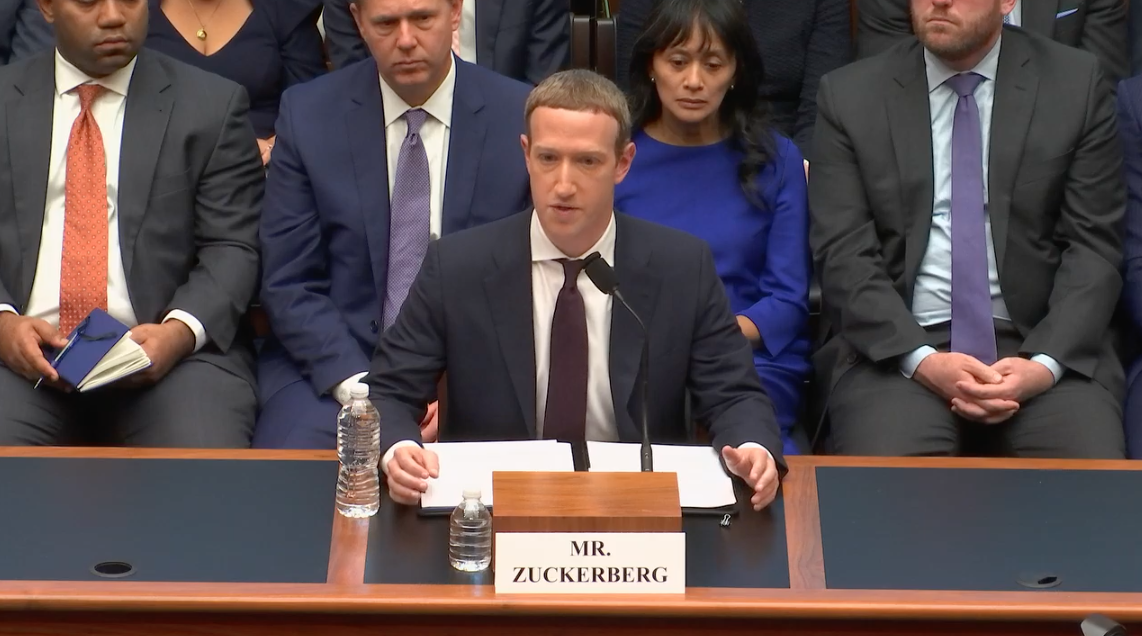
With few highlights or positive moments coming from the hearing, here are the major takeaways followed by a chronicle of the top exchanges between Zuckerberg and Congress:
Zuckerberg tried to leverage nationalist sentiment to deflect scrutiny. “As soon as we put forward the white paper around the Libra project, China immediately announced a public private partnership, working with companies . . . to extend the work that they’ve already done with AliPay into a digital Renminbi as part of the Belt and Road Initiative that they have, and they’re planning on launching that in the next few months.” He later said that for Libra, “Chinese companies would be the primary competitors.”
Facebook’s executives have repeatedly leaned on this “let us, or China will” argument we chronicle here.
What if the Libra Association chooses to add the Chinese currency to the basket used to back Libra and reduces the U.S. dollar’s fraction of the basket? “I think it would be completely reasonable for our regulators to try to [implement] a restriction that says that it has to be primarily U.S. dollars,” Zuckerberg responded in one of his most substantial answers of the day. Zuckerberg was receptive to feedback that the Libra Association should keep its white paper updated.
As for why Libra isn’t just backed 100% with the U.S. dollar, Zuckerberg explained that “I think from a U.S. regulatory perspective, it would probably be significantly simpler. But because we’re trying to build something that can also be a global payment system that works in other places, it may be less welcome in other places if it’s only 100% based on the dollar.” Still, Zuckerberg said he would leave his children their inheritance in Libra because it’s backed one-to-one by the Libra reserve.
Zuckerberg wouldn’t commit to blocking anonymous Libra wallets that could facilitate money laundering, only saying Facebook’s own Calibra wallet would have strong identity checks. He did say Libra was exploring whether it could encode “know your customer” protections at the network level instead of relying on developers to build this into their wallets.
On whether Facebook will increasingly seek to verify users’ identities through government ID, Zuckerberg was enthusiastic. “This is an area where I think we are going to do a lot more in the years to come. We started with political ads . . . over the coming years for anything that people are doing that is sensitive, we’re likely going to increasingly require verification either by government ID or other things so we can have a clear sense of people’s authentic identity.”
Rep. Dean Phillips (D-MN) mentioned this could be a competitive advantage, implying Facebook’s size and resources might allow it to embark on a verification initiative other companies couldn’t.
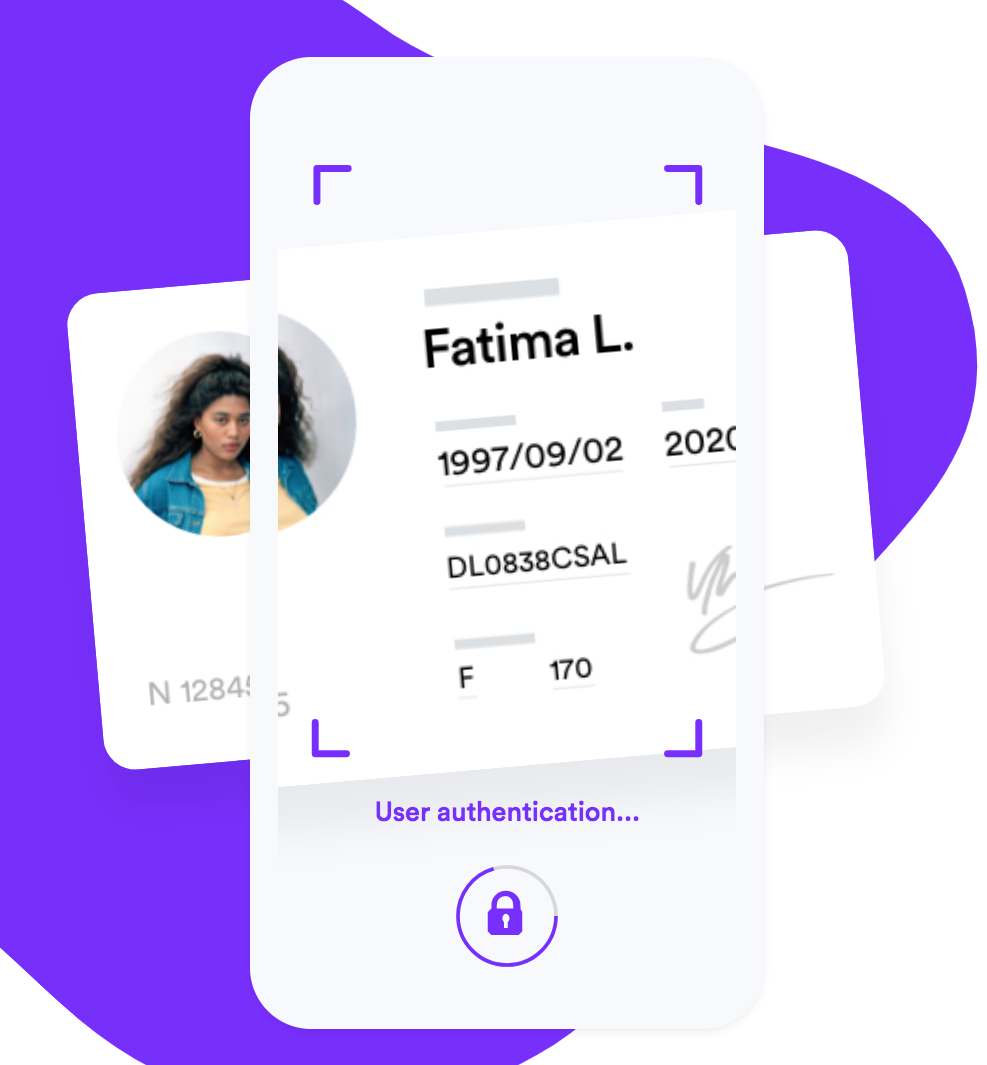
Facebook has assured regulators that Calibra’s data would be kept separate from the social network. But Facebook said the same when it acquired WhatsApp, then reneged and integrated its data. This time around, Congresswoman Nydia Velázquez declared that “we’re going to need to make sure that . . . you learned that you should not lie.”
When pushed on why Libra Association members like Visa, Stripe and eBay left the organization, Zuckerberg admitted, “I think because it’s a risky project and there’s been a lot of scrutiny.” Zuckerberg struck back at finance incumbents, saying “I think that the U.S. financial industry . . . is just frankly behind where it needs to be to innovate and continue American financial leadership going forward.”
In an awkward moment, Zuckerberg could not answer which Libra members were run by women, minorities or LGBTQ+ people. “Is it true that the overwhelming majority of persons associated with this endeavor are white men?,” Rep. Al Green (D-TX) asked. “Congressman, I don’t know off the top of my head,” Zuckerberg responded.
Zuckerberg was criticized for trying to profit and potentially helping money laundering while claiming Libra is designed to help the unbanked. Zuckerberg said the Libra Association “hadn’t nailed down policies” about whether anonymous payments are allowed.
Rep. Brad Sherman (D-CA) said “for the richest man in the world to come here and hide behind the poorest people in the world, and say that’s who you’re really trying to help. You’re trying to help those for whom the dollar is not a good currency — drug dealers, terrorists.” Some members of Congress like Sherman chose to use their entire time monologuing instead of actually asking questions.
Zuckerberg got a chance to clear up a major snafu from Marcus’ testimony, where he said the Libra Association was in contact with the Swiss data regulator, which CNBC reported hadn’t heard from Libra. Zuckerberg explained today that the Libra Association had been in contact with the primary Swiss Financial Market Supervisory Authority instead. He says Facebook plans to earn money from Libra on ads from small businesses if cheap transactions lead to more e-commerce.
In one revealing exchange, Rep. Lance Gooden (R-TX) asked if the Libra Association still planned to offer profit incentives by offering dividends based on interest earned on currency in the Libra reserve after expenses are paid. Zuckerberg said the idea had either been “modified or abandoned.”

The highlighted section detailing how Libra Association members earn dividends on Libra reserve interest has been removed from the Libra whitepaper
Throughout the testimony, Zuckerberg tried to distance himself and Facebook from the Libra Association’s decision making process. “We might be required to pull out if the Association independently decides to move forward on something that we’re not comfortable with,” Zuckerberg said. That means if Facebook can’t launch Libra, it could still theoretically launch without the social network, though it does most of the engineering heavy-lifting.
The strategy was crystallized by Zuckerberg’s response to whether he could commit to moving Libra’s headquarters from Switzerland to the U.S. “At this point, we do not control the independent Libra Association so I don’t think we can make that decision.” Rep. Ayanna Pressley (D-MA) refuted this position, stating, “Mr. Zuckerberg, Libra is Facebook, and Facebook is you.”
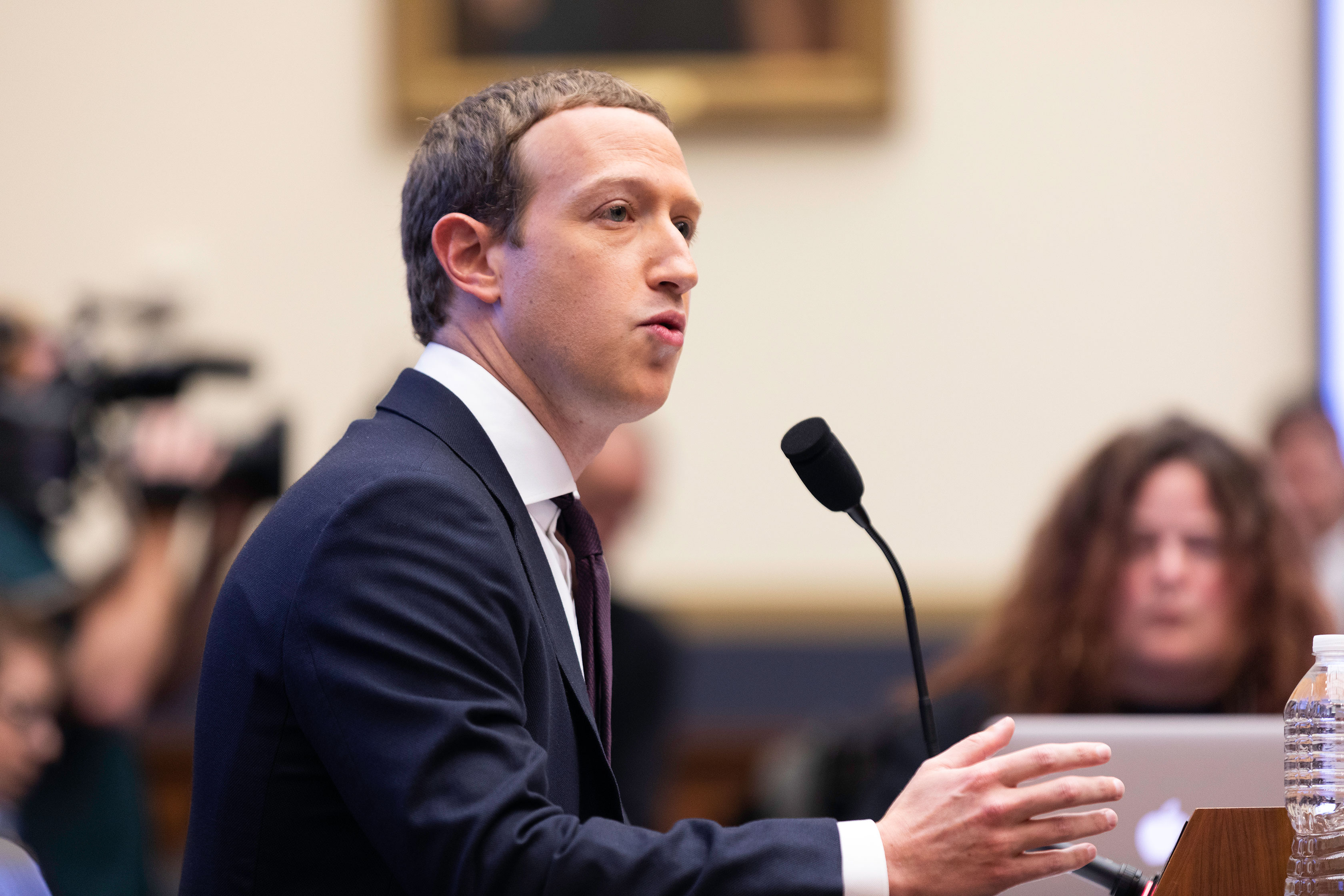
The Facebook CEO, Mark Zuckerberg, testified before the House Financial Services Committee on Wednesday October 23, 2019 Washington, D.C. (Photo by Aurora Samperio/NurPhoto via Getty Images)
The “we don’t control Libra” argument provides Facebook and Libra an escape hatch from criticism, because any member and even the newly appointed chairperson and board can’t unilaterally control or make promises about its actions.
Many Congress members remain fixated on Facebook’s recently solidified policy of refusing to submit political ads for fact-checking. Rep Sean Casten (D-IL) asked if in Zuckerberg’s recent meeting with President Trump, “Did anyone discuss the policy change along the exemption of political figures and parties from misinformation prohibition on Facebook?” Zuckerberg responded, “Congressman, that did not come up,” quieting theories that Trump pushed for the policy that would exempt false claims in his ads.
Zuckerberg defended the policy to Rep. Alexandria Ocasio-Cortez (D-NY), saying “I think lying is bad, and I think if you were to run an ad that had a lie, that would be bad,” but that outside of calls for violence or voter suppression, Facebook thinks it’s best to leave lies in ads from politicians so they can be scrutinized by the press and public. Yet that too heavily leans on the media to scrutinize thousands of ad variants being run as part of multi-hundred-million-dollar political ad campaigns.
Rep. Ann Wagner (R-MO) chided Zuckerberg, saying “you’re not working hard enough” to stop the spread of child exploitation imagery online despite Facebook submitting millions of reports. She brought up worries that Facebook moving entirely to encrypted messaging could hide child abusers, and Zuckerberg merely said “I think we work harder than any other company.” He failed to explain how Facebook would continue improving detection through encryption.
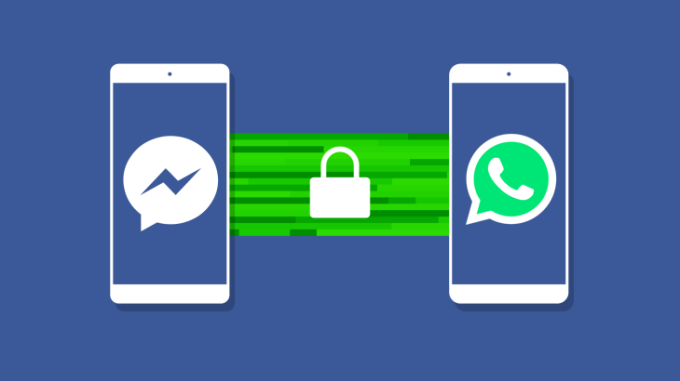
Oddly, Zuckerberg was directly confronted about his views on vaccines since Facebook works to hide vaccine hoaxes and avoid recommending groups spreading unverified information about them. “I don’t think it would be possible for anyone to be 100% confident, but my understanding of the scientific consensus is that it is important that people get their vaccines,” Zuckerberg said, defending Facebook’s decision to hide some of this content.
In another strange moment, Rep. Madeleine Dean (D-PA) demanded if Facebook had bought blocks of hotel rooms at Trump properties but never used them just to curry favor with the president. Zuckerberg said he’d never heard of that and would be surprised if it was true.
On deepfakes, Zuckerberg confirmed that “I think deepfakes are clearly one of the emerging threats that we need to get in front of and develop policy around to address. We’re currently working on what the policy should be to differentiate between media that has manipulated and been manipulated by AI tools like deepfakes, with the intent to mislead people.” Zuckerberg later said the doctored Nancy Pelosi video should have been flagged sooner, and highlighted Facebook needs a separate deepfakes policy. Yet Facebook’s policy allows politicians’ ads to mislead people, weakening faith that it will properly address this new problem.
Questions about Facebook’s fair practices led Zuckerberg to reiterate his call for regulation, saying “I think we need federal privacy legislation. I think we need data portability legislation. I think clear rules on elections-related content would be helpful too because it’s not clear to me that we want private companies making so many decisions on these important areas by themselves.”
Regarding housing discrimination via Facebook ads, Zuckerberg committed to working with regulators to provide information under subpoena, noted Facebook has banned discriminatory housing ads, and said “Nobody wants to redline and I’m sure that was accidental.”
Zuckerberg received his heaviest criticism of the day from Rep. Joyce Beatty (D-OH), who grilled him about not knowing if diverse bankers manage Facebook’s cash or if diverse law firms handle its court cases. She chastised Facebook for a lack of diverse leadership, saying “this is appalling and disgusting to me.” Of COO Sheryl Sandberg, who leads Facebook’s civil rights task force, Beatty said “we know she’s not really civil rights.”
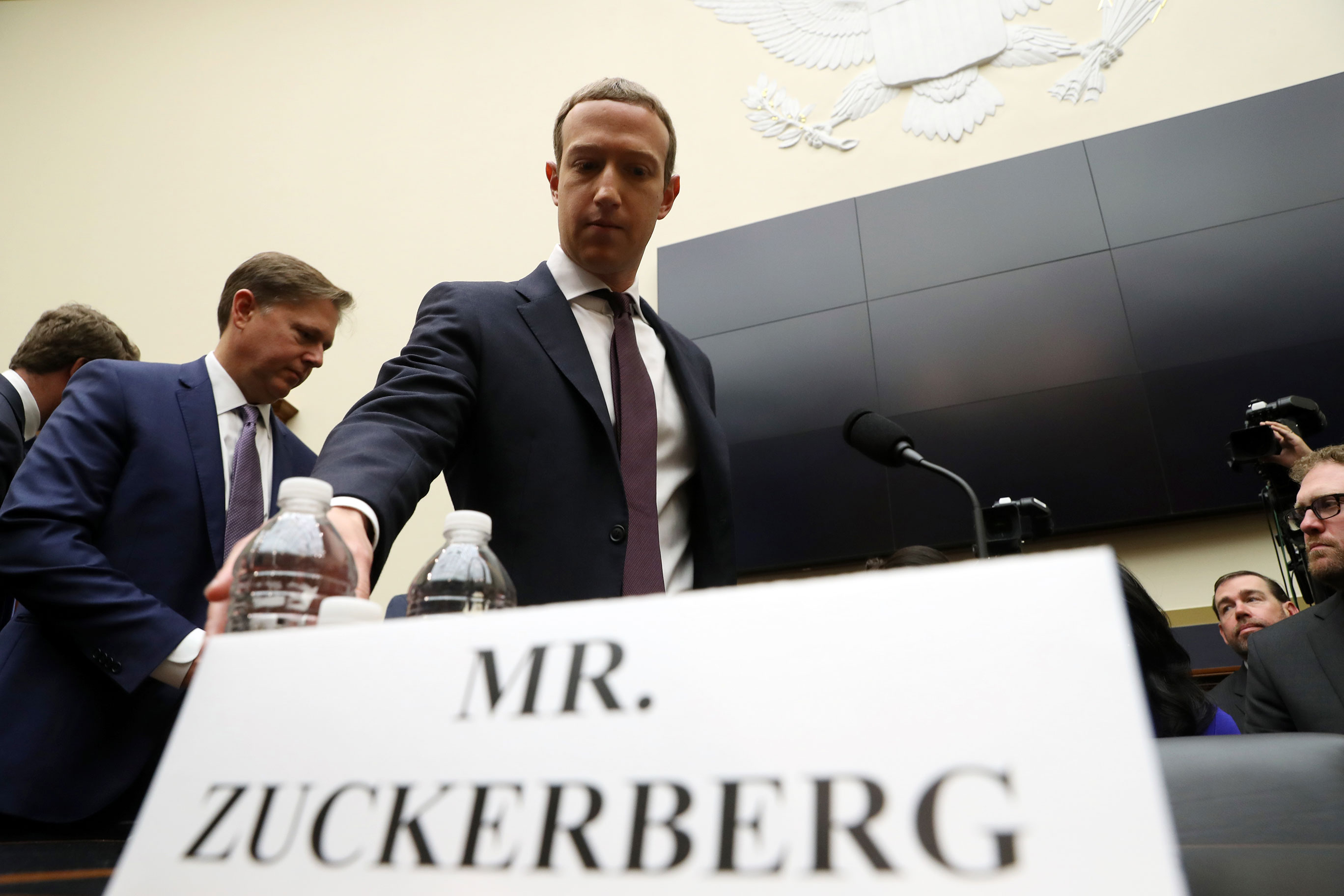
WASHINGTON, DC – OCTOBER 23: Facebook co-founder and CEO Mark Zuckerberg arrives to testify before the House Financial Services Committee in the Rayburn House Office Building on Capitol Hill October 23, 2019 in Washington, DC. Zuckerberg testified about Facebook’s proposed cryptocurrency Libra, how his company will handle false and misleading information by political leaders during the 2020 campaign and how it handles its users’ data and privacy. (Photo by Chip Somodevilla/Getty Images)
Some of the day’s most astute questioning came from Congresswoman Katherine Porter (D-CA). She hammered Zuckerberg about Facebook lawyers fighting to avoid liability over data breaches. Then she trapped Zuckerberg on the issue of the mental health harms of being a Facebook content moderator that reviews horrific and graphic violence.
“Would you be willing to commit to spending one hour a day for the next year, watching these videos and acting as a content monitor and only accessing the same benefits available to your workers?,” she asked. “I’m not sure that would serve our community for me to spend my time,” Zuckerberg said. “What you’re saying is you’re not willing to do it,” she replied.
Rep. Katie Porter challenges Mark Zuckerberg to work as a content moderator and view the same violent, disturbing videos Facebook contractors do https://t.co/iVB9nAcvHO pic.twitter.com/TfPuXkiJp8
— Bloomberg Technology (@technology) October 23, 2019
There’ll be more major launches from Facebook that could raise questions about its impact on society, Zuckerberg revealed. “Later this week we actually have a big announcement coming up on launching a big initiative around news and journalism, where we’re partnering with a lot of folks to build a new product that’s supporting high-quality journalism.” Facebook plans to launch a News section featuring headlines from top outlets, though only some will be paid.

“I think that there’s an opportunity within Facebook in our services to build a dedicated surface, a tab within the apps for example, where people who really want to see high quality curated news, not just social content . . . I’m looking forward to discussing that in more length in the coming days.” That service is sure to trigger debates about whether Facebook is trustworthy enough to be a formal conduit for news.
Overall, the questioning today was much more intelligent than the vague and easily-Googleable queries launched at Zuckerberg by Congress in April 2018. We had no “Senator, we run ads” moments. Instead, it was Zuckerberg who repeatedly used the separation between Facebook and the Libra Association plus the fact that Libra’s policies are still being defined to avoid giving many substantial answers. Combined with the short five-minute Q&A period per member of Congress, Zuckerberg was often able to just repeat existing talking points.
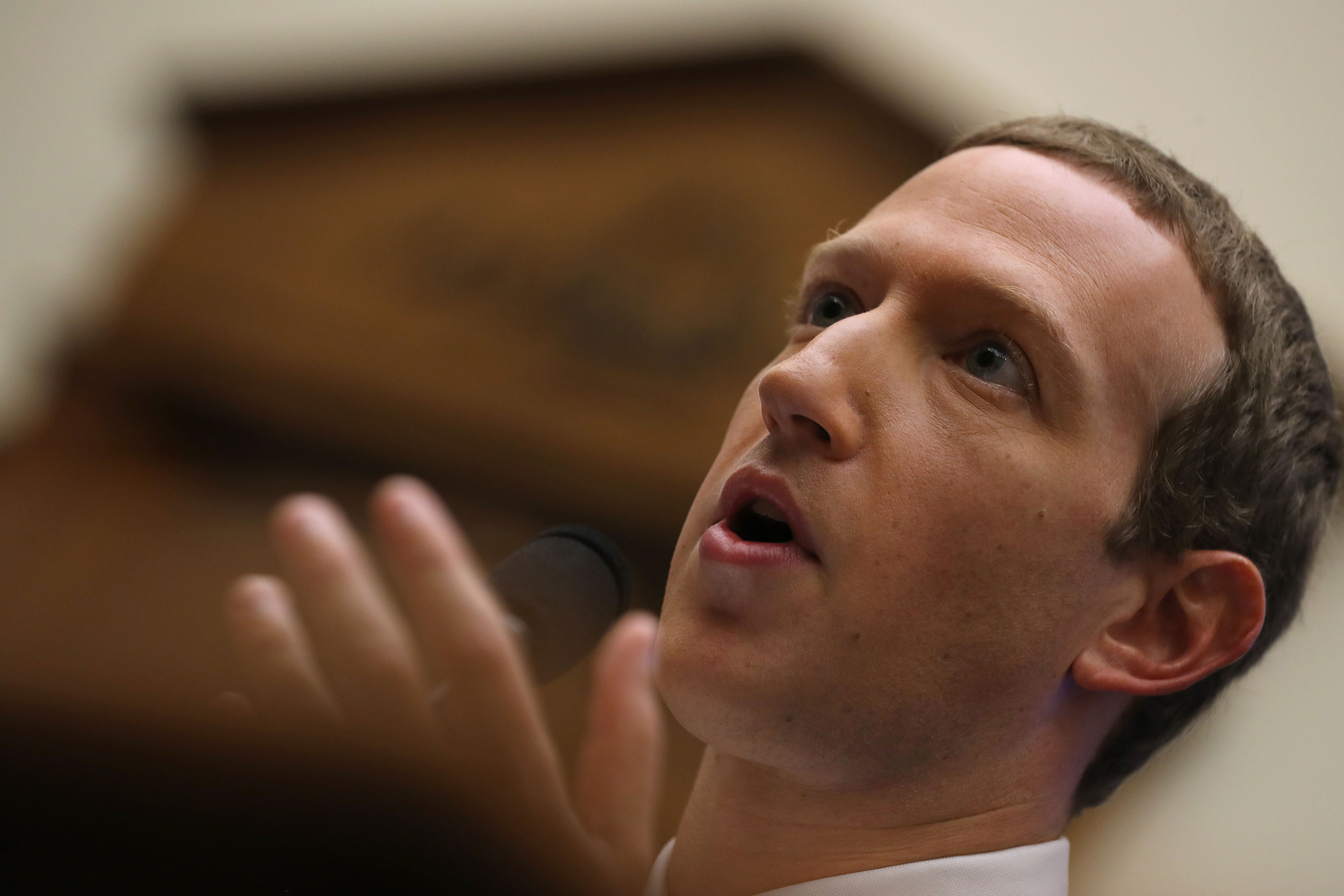
WASHINGTON, DC – OCTOBER 23: Facebook co-founder and CEO Mark Zuckerberg testifies before the House Financial Services Committee in the Rayburn House Office Building on Capitol Hill October 23, 2019 in Washington, DC. Zuckerberg testified about Facebook’s proposed cryptocurrency Libra, how his company will handle false and misleading information by political leaders during the 2020 campaign and how it handles its users’ data and privacy. (Photo by Chip Somodevilla/Getty Images)
In one of the few lighthearted moments of the day, Rep. Juan Vargas recognized the tough position Zuckerberg has gotten himself into. “It’s good to have someone that’s sturdy and resilient. You’re probably the right person at the right time to take this beating.” Yet Rep. McHenry depressingly concluded that, after six hours, “I’m not sure we’ve learned anything new here.”
The question is what array of Libra and Facebook executives would Congress need to have testify together to get real answers to critical questions about how to keep the two from harming the global economy.
The hearing is ongoing and we’ll continue to update this article with major take-aways.
Powered by WPeMatico
The Snap-back continues. Snapchat blew past earnings expectations for a big beat in Q3, as it added 7 million daily active users this quarter to hit 210 million, up 13% year-over-year. Snap also beat on revenue, notching $446 million, which is up a whopping 50% year-over-year, at a loss of $0.04 EPS. That flew past Bloomberg’s consensus of Wall Street estimates that expected $437.9 million in revenue and a $0.05 EPS loss.
Snap has managed to continue cutting losses as it edges toward profitability. Net loss improved to $227 million from $255 million last quarter, with the loss decreasing $98 million versus Q3 2018.
CEO Evan Spiegel made his case in his prepared remarks for why Snapchat’s share price should be higher: “We are a high-growth business, with strong operating leverage, a clear path to profitability, a distinct vision for the future and the ability to invest over the long term.”
Snapchat’s share price had closed down 4% at $14, and had fallen roughly 4.6% in after-hours trading as of 1:50 pm Pacific, to $13.35, despite the earnings beat. It remains below its $17 IPO price but has performed exceedingly well this year, rising from a low of $4.99 in December.
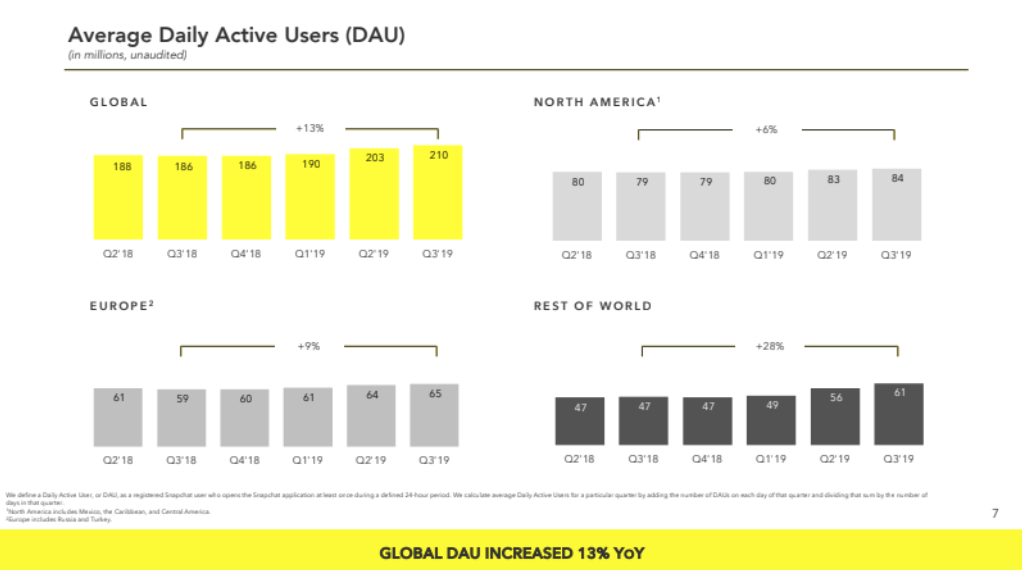
That’s partially because of the high cost of Snapchat’s growth relative average revenue per user. While it notes that it saw user growth in all regions, 5 million of the 7 million new users came from the Rest of World, with just 1 million coming from the North America and Europe regions. That’s in part thanks to better than expected growth and retention on its re-engineered Android app that’s been a hit in India. But since Snapchat serves so much high-definition video content but it earns just $1.01 average revenue in the Rest of World, it has to hope it can keep growing ARPU so it becomes profitable globally.
Some other top-line stats from Snapchat’s earnings:
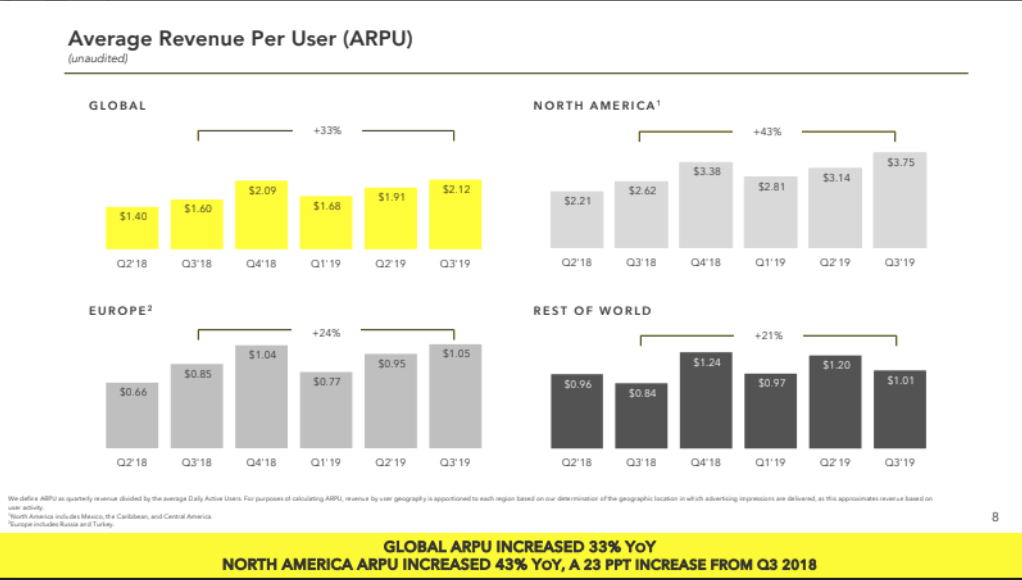
Interestingly, Spiegel noted that “We benefited from year-over-year growth in user activity in Q3 including growth in Snapchatters posting and viewing Stories.” Snapchat hadn’t indicated Stories was growing in at least the past two years, as it was attacked by clones, including Instagram Stories that led Snapchat to start shrinking in user count a year ago before it recovered.
Since Stories viewership is critical to total ad view on Snapchat, we may see analysts insisting to hear more about that metric in the future. Snap also said users opened the app 30 times per day, up from 25 times per day as of July 2018, showing it’s still highly sticky and being used for rapid-fire visual communication.
The other major piece of Snapchat’s ad properties is Discover, where total time spent watching grew 40% year-over-year. And rather than being driving by just a few hits, more than 100 Discover channels saw over 10 million viewers per month in Q3. With Instagram’s IGTV a flop, Discover remains Snapchat’s best differentiated revenue driver, and one it needs to keep investing in and promoting. With Instagram trying to compete more heavily on chat with its new close friends-only Threads app, Snapchat can’t rely on ephemeral messaging to keep it special.
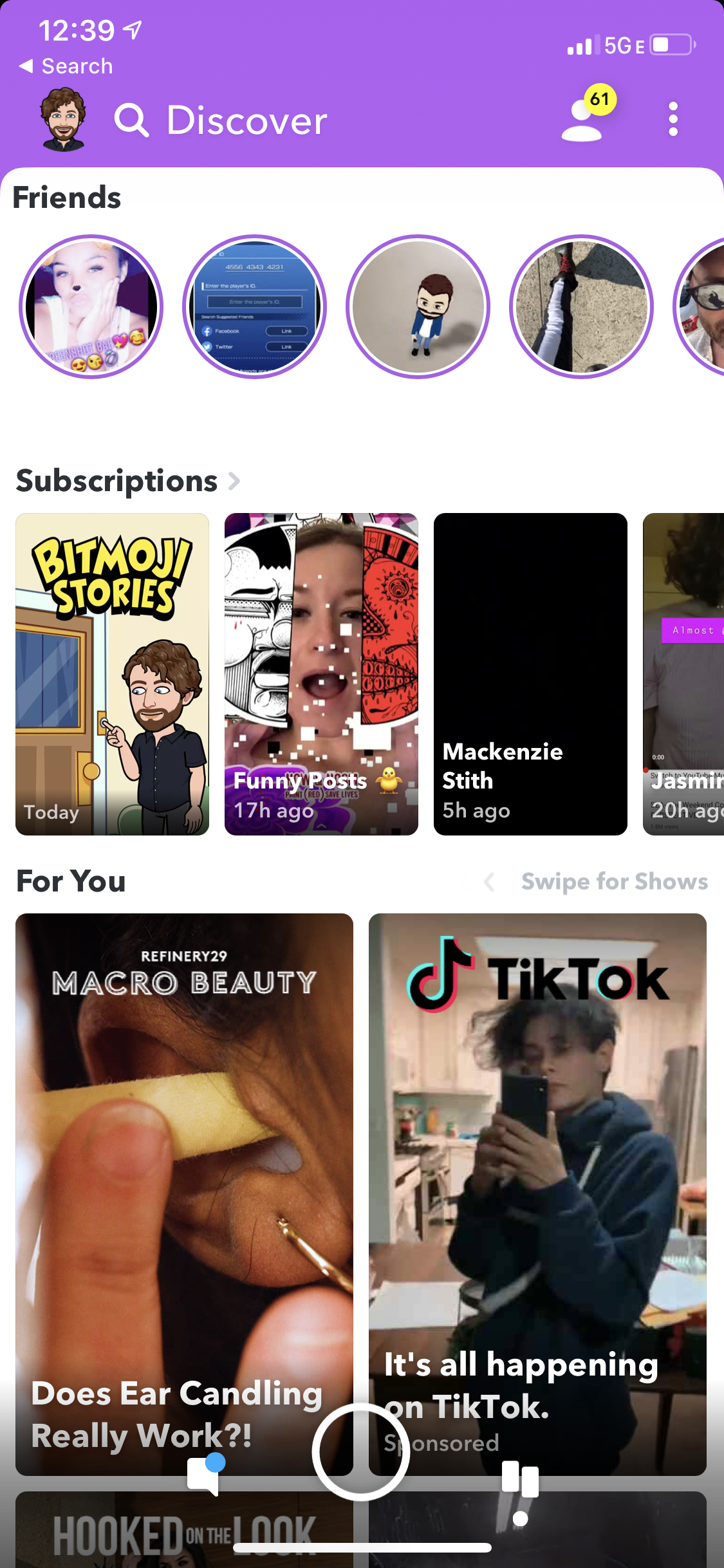
TikTok buys ads on Snapchat that could steal its users
Surprisingly, Spiegel said that “We definitely see TikTok as a friend” when asked about why it allowed the competitor to continue buying ads on Snapchat. The two apps are different, with Snapchat focused on messaging and biographical social media while TikTok is about storyboarded, premeditated social entertainment. But this could be a dangerous friendship for Snapchat, as TikTok may be taking time away that users might spend watching Snapchat Discover, and its growth could box Snapchat out of the social entertainment space.
Looking forward, in Q4 Snap is estimating 214 to 215 million daily active users and $540 million to $560 million in revenue. It’s expecting between break even and positive $20 million for adjusted EBITDA. That revenue guidance was below estimates for the holiday Q4, contributing to the share price fall.
Snap has a ways to go before reaching profitability. That milestone would let it more freely invest in long-term projects, specifically its Spectacles camera-glasses. Spiegel has said he doesn’t expect augmented reality glasses to be a mainstream consumer product for 10 years. That means Snap will have to survive and spend for a long time if it wants a chance to battle Apple, Facebook, Magic Leap and more for that market.
Powered by WPeMatico
As Slack has grown in popularity, one of the company’s key differentiators has been the ability to integrate with other enterprise tools. But as customers use Slack as a central work hub, it has created its own set of problems. In particular, users have trouble understanding which apps they have access to and how to make best use of them. Slack announced several ways to ease those issues at its Spec developer conference today.
Andy Pflaum, director of Slack platform, points out there are 1,800 app integrations available out of the box in Slack, and developers have created 500,000 additional custom apps. That’s obviously far too many for any user to keep track of, so Slack has created a home page for apps. Called App Launcher, it acts a bit like the Mac Launchpad — a centralized place where you can see your installed apps.
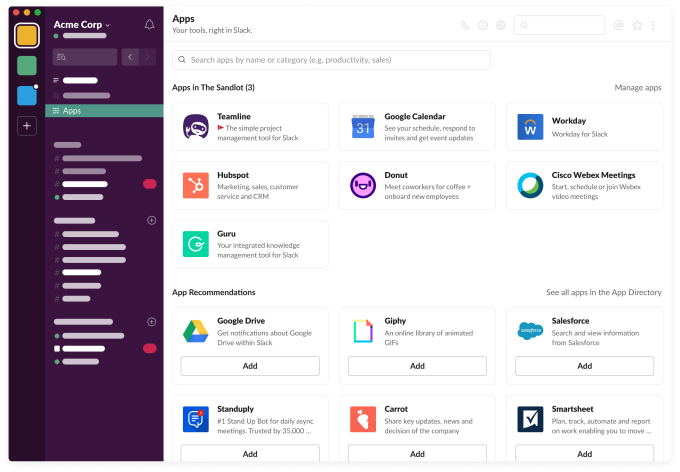
Slack App Launcher (Image: Slack)
You access App Launcher from the Slack sidebar by clicking Apps. It opens App Launcher with the apps that make sense for you. When you select an app, Pflaum says it takes you to that app’s home screen where it will be ready to enter or display relevant information.
For example, if you selected Google Calendar, you would see your daily schedule along with meeting requests, which you can accept or reject. You also can launch meeting software directly from this page. All of this happens within Slack, without having to change focus. App Home will be available in beta in the next few months, according to Pflaum.
Another way Slack is helping ease the app burden is with a new concept called Actions from Anywhere. The company actually launched Actions last year, enabling users to take an action from a message like attaching a Slack message to a pull request in Jira, as an example. Pflaum said that people liked these actions so much they were requesting the ability to take actions from anywhere in Slack.
“At Spec, we are previewing this new kind of action — Actions from Anywhere — which gives users the ability to take an action from anywhere they are in Slack,” Pflaum said. To really take advantage of this capability, the company is adding a feature to select the five most recent actions from a quick-access menu. These actions fill in automatically based on your most recent activities, and could be a real time-saver for people working inside Slack all day.
Finally, the company is enabling developers to open an external window inside Slack, what they call Modal windows, which open when users have to fill out a form, take a survey, enter expenses or provide additional information outside the flow of Slack itself.
All of these and other announcements at Spec are part of the maturation process of Slack as it moves to solve some of the pain points of growing so quickly. When you grow past the point of understanding what a complex piece of software can do, it’s up to the vendor to provide ways to surface all of the benefits and features, and that’s what Slack is attempting to do with these new tools.
Powered by WPeMatico
Aurora Insight, a startup that provides a “dynamic” global map of wireless connectivity that it built and monitors in real time using AI combined with data from sensors on satellites, vehicles, buildings, aircraft and other objects, is emerging from stealth today with the launch of its first publicly available product, a platform providing insights on wireless signal and quality covering a range of wireless spectrum bands, offered as a cloud-based, data-as-a-service product.
“Our objective is to map the entire planet, charting the radio waves used for communications,” said Brian Mengwasser, the co-founder and CEO. “It’s a daunting task.” He said that to do this the company first “built a bunker” to test the system before rolling it out at scale.
With it, Aurora Insight is also announcing that it has raised $18 million in funding — an aggregate amount that reaches back to its founding in 2016 and covers both a seed round and Series A — from an impressive list of investors. Led by Alsop Louie Partners and True Ventures, backers also include Tippet Venture Partners, Revolution’s Rise of the Rest Seed Fund, Promus Ventures, Alumni Ventures Group, ValueStream Ventures and Intellectus Partners.
The area of measuring wireless spectrum and figuring out where it might not be working well (in order to fix it) may sound like an arcane area, but it’s a fairly essential one.
Mobile technology — specifically, new devices and the use of wireless networks to connect people, objects and services — continues to be the defining activity of our time, with more than 5 billion mobile users on the planet (out of 7.5 billion people) today and the proportion continuing to grow. With that, we’re seeing a big spike in mobile internet usage, too, with more than 5 billion people, and 25.2 billion objects, expected to be using mobile data by 2025, according to the GSMA.
The catch to all this is that wireless spectrum — which enables the operation of mobile services — is inherently finite and somewhat flaky in how its reliability is subject to interference. That in turn is creating a need for a better way of measuring how it is working, and how to fix it when it is not.
“Wireless spectrum is one of the most critical and valuable parts of the communications ecosystem worldwide,” said Rohit Sharma, partner at True Ventures and Aurora Insight board member, in a statement. “To date, it’s been a massive challenge to accurately measure and dynamically monitor the wireless spectrum in a way that enables the best use of this scarce commodity. Aurora’s proprietary approach gives businesses a unique way to analyze, predict, and rapidly enable the next-generation of wireless-enabled applications.”
If you follow the world of wireless technology and telcos, you’ll know that wireless network testing and measurement is an established field — about as old as the existence of wireless networks themselves (which says something about the general reliability of wireless networks). Aurora aims to disrupt this on a number of levels.
Mengwasser — who co-founded the company with Jennifer Alvarez, the CTO who you can see presenting on the company here — tells me that a lot of the traditional testing and measurement has been geared at telecoms operators, who own the radio towers, and tend to focus on more narrow bands of spectrum and technologies.
The rise of 5G and other wireless technologies, however, has come with a completely new playing field and set of challenges from the industry.
Essentially, we are now in a market where there are a number of different technologies coexisting — alongside 5G we have earlier network technologies (4G, LTE, Wi-Fi); and a potential set of new technologies. And we have a new breed of companies building services that need to have close knowledge of how networks are working to make sure they remain up and reliable.
Mengwasser said Aurora is currently one of the few trying to tackle this opportunity by developing a network that is measuring multiples kinds of spectrum simultaneously, and aims to provide that information not just to telcos (some of which have been working with Aurora while still in stealth) but the others kinds of application and service developers that are building businesses based on those new networks.
“There is a pretty big difference between us and performance measurement, which typically operates from the back of a phone and tells you when have a phone in a particular location,” he said. “We care about more than this, more than just homes, but all smart devices. Eventually, everything will be connected to network, so we are aiming to provide intelligence on that.”
One example are drone operators that are building delivery networks: Aurora has been working with at least one while in stealth to help develop a service, Mengwasser said, although he declined to say which one. (He also, incidentally, specifically declined to say whether the company had talked with Amazon.)
5G is a particularly tricky area of mobile network spectrum and services to monitor and tackle, which is one reason why Aurora Insight has caught the attention of investors.
“The reality of massive MIMO beamforming, high frequencies, and dynamic access techniques employed by 5G networks means it’s both more difficult and more important to quantify the radio spectrum,” said Gilman Louie of Alsop Louie Partners, in a statement. “Having the accurate and near-real-time feedback on the radio spectrum that Aurora’s technology offers could be the difference between building a 5G network right the first time, or having to build it twice.” Louie is also sitting on the board of the startup.
Powered by WPeMatico
Bootstrapped tech company Doist, the company behind popular task management Todoist, is releasing a major update called Todoist Foundations — the update should be rolled out over the next 24 hours. As the name suggests, it lays foundations for many new features down the road.
But there are already some interesting improvements. Task lists in Todoist don’t have to be an endless list of checkboxes anymore. You can now create sections in your projects. You can then move tasks from one section to another, and collapse sections when you don’t need to see them.

Down the road, those sections could play a bigger role. For instance, a project could have sections representing multiple steps to achieve a task. You could imagine other views that let you move a task from one step to another.
When it comes to labels, they are now sorted in two categories — your personal labels and shared labels with other co-workers.
Todoist has also added a new task view on desktop and mobile that centralizes everything you can do related to a task. You can modify the due date and priority level, see comments, add labels and more. Even better, you can see all the subtasks associated with a specific task in this new view.
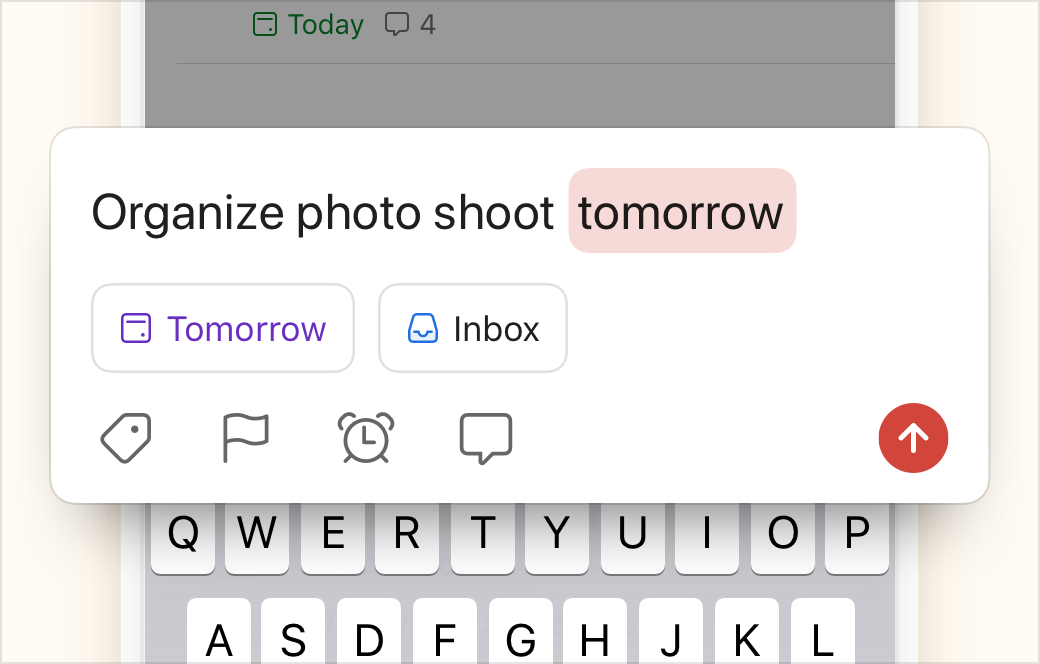
When it comes to mobile-specific improvements, the quick add bar has been overhauled. Quick add has always been one of my favorite features in Todoist. For instance, you can type “Send contract tomorrow at 9am @bestclient #work” to create a “Send contract” task in the “work” project, with a due date and the label “bestclient.”
Todoist first added buttons on mobile to surface those features and make them more intuitive. The company is simplifying the bar as it got really busy. It now displays existing due dates, projects and assignees in buttons directly. There are now fewer icons for less-important features.
Todoist also borrowed a feature from Things 3 with the plus button. You can now drag and drop the plus button anywhere in a list to add a new task in the middle of the list. That feature is incredibly useful.
Behind the scene, everything should be faster as well. Finally, Todoist updated icons and its color palette.
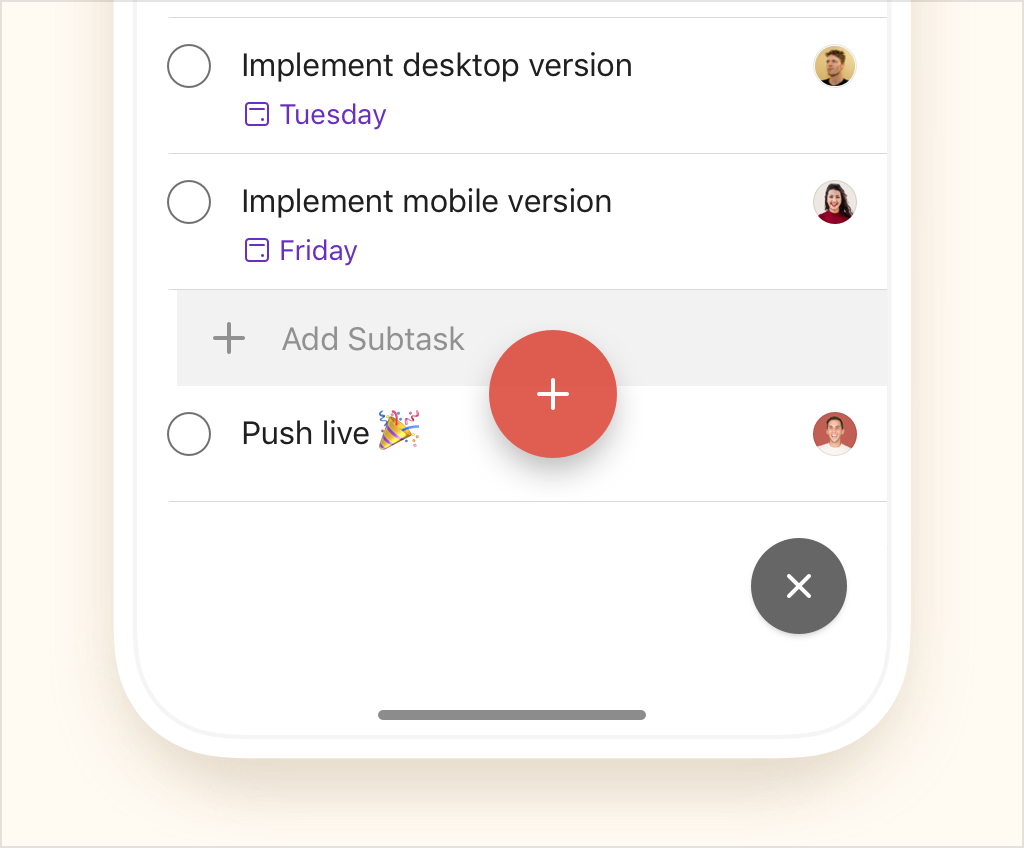
Powered by WPeMatico
In China, Toutiao is literally big news.
Not only has its parent company ByteDance achieved a $75 billion valuation, two of its apps — Toutiao, a news aggregator, and Douyin (Tik Tok in China) — are chipping into WeChat’s user engagement numbers, no small feat considering the central role WeChat plays in the daily lives of the region’s smartphone users.
The success of Toutiao (its name means “headline”) prompts the question: why hasn’t one news aggregator app achieved similar success in the United States? There, users can pick from a roster of news apps, including Google News, Apple News (on iOS), Flipboard, Nuzzel and SmartNews, but no app is truly analogous to Toutiao, at least in terms of reach. Many readers still get news from Google Search (not the company’s news app) and when they do use an app for news, it’s Facebook.
The top social media platform continues to be a major source of news for many Americans, even as they express reservations about the reliability of the content they find there. According to research from Columbia Journalism Review, 43% of Americans use Facebook and other social media platforms to get news, but 57% said they “expect the news they see on those platforms to be largely inaccurate.” Regardless, they stick with Facebook because it’s timely, convenient and they can share content with friends and read other’s comments.
The social media platform is one of the main reasons why no single news aggregator app has won over American users the same way Toutiao has in China, but it’s not the only one. Other factors, including differences between how the Internet developed in each country, also play a role, says Ruiwan Xu, the founder and CEO of CareerTu, an online education platform that focuses on data analytics, digital marketing and research.
While Americans first encountered the Internet on PCs and then shifted to mobile devices, many people in China first went online through their smartphones and the majority of the country’s 800 million Internet users access it through mobile. This makes them much more open to consuming content — including news and streaming video — on mobile.
Powered by WPeMatico
Chad Hurley is hunting for what comes after fantasy sports. He envisions a new way for fans to play by watching live and cheering for the athletes they love. Beyond a few scraps of info the YouTube co-founder would share and his new startup’s job listings revealed, we don’t know what Hurley’s game will feel like. But the company is called GreenPark Sports, and it’s launching in spring 2020.
“There is an absence of compelling, inclusive ways for large masses of sports fans to compete together,” Hurley tells me. “The idea of a ‘sports fan’ has evolved -0 it is now more a social behavior than ever before. We’re looking at a much bigger, inclusive way for all fans of sports and esports teams to play.”
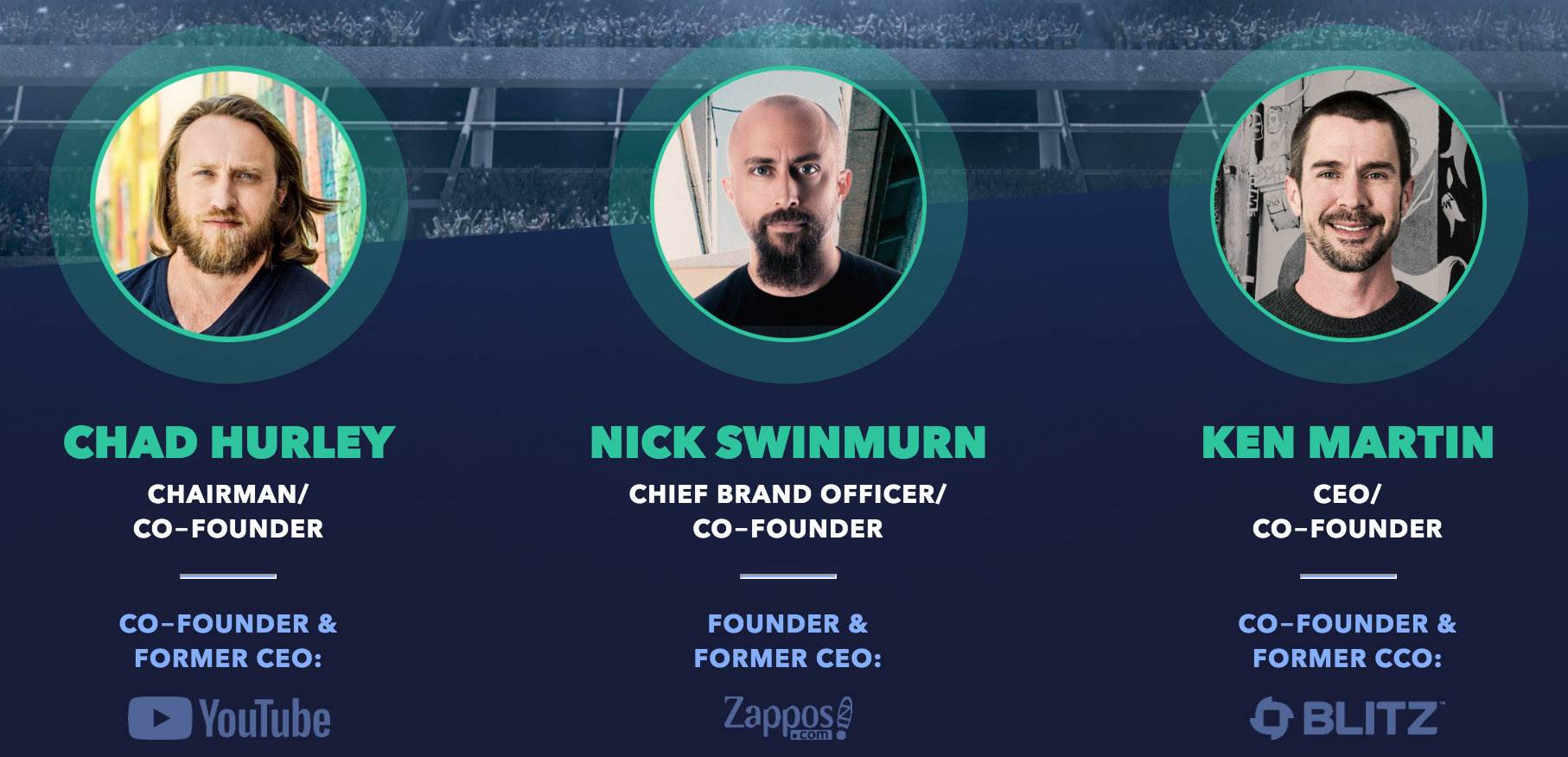
Hurley already has an all-star team. One of GreenPark’s co-founders, Nick Swinmurn, helped start Zappos, while another, Ken Martin, created marketing agency BLITZ. Together they’ve raised an $8.5 million seed round led by SignalFire and joined by Sapphire Sports and Founders Fund. “With this team’s impeccable track record and vision for the future of fandom, this was an investment we had to make,” said Chris Farmer, founder and CEO of SignalFire .
It all comes down to allegiance — something Hurley, Swinmurn and Martin truly understand. Everyone is seeking ways to belong and emblems to represent them. In an age when many of our most prized possessions, from photographs to record collections, have been digitized, we lack tangible objects that center our individuality. Culture increasingly centers around landmark events, with what we’ve done mattering more than what we own.
GreenPark could seize upon this moment by helping us align our identities with a team. This instantly unlocks a like-minded community, a recurrent activity and a unified aesthetic. And when reality gets heavy, people can lose themselves by hitching their spirits to the scoreboard.
Rather than just tabulating results after the match like in fantasy sports, GreenPark wants to be entwined with the spectacle as it happens. “We’re going to be working with a mix of ways to visualize the live game — from unique gamecast-like data to highlight clips. The social viewing experience can be much more than just the straight live video,” Hurley explains.
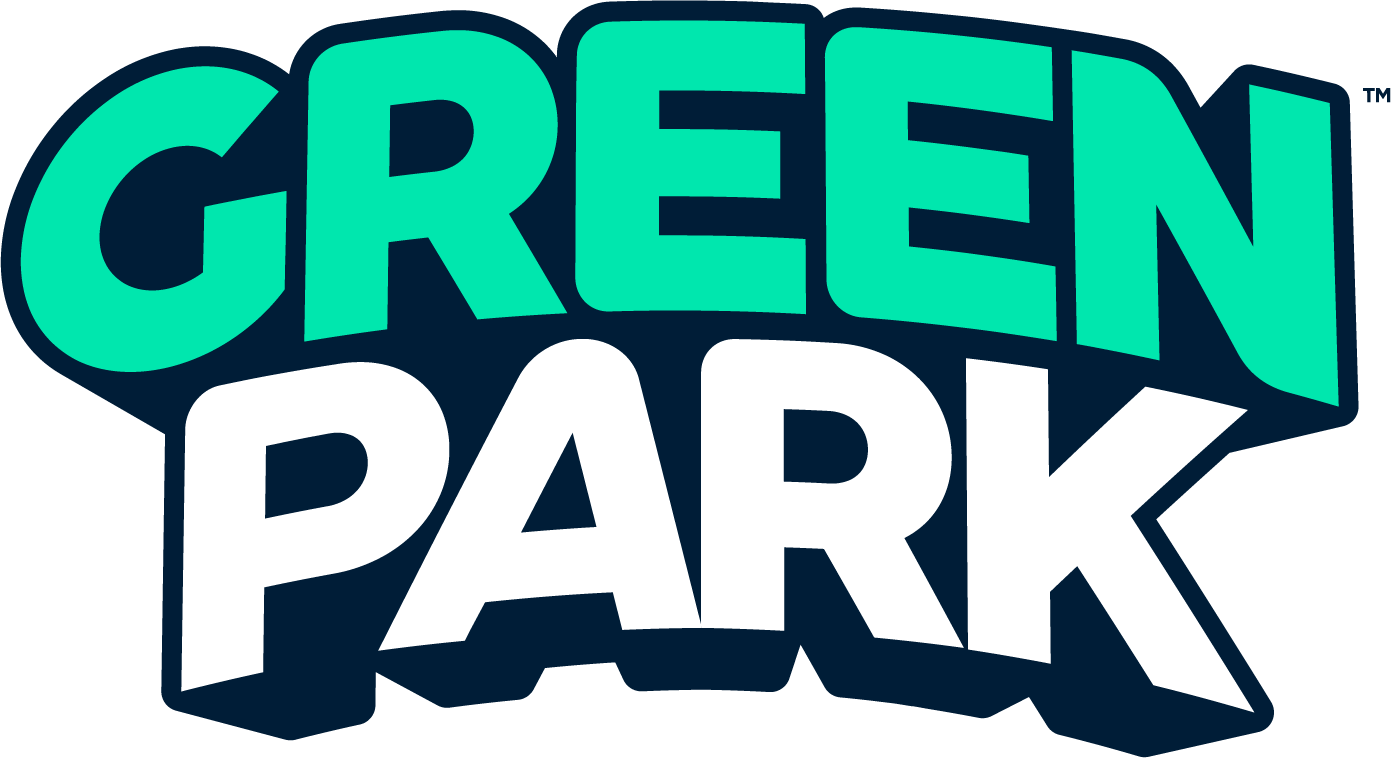
He came up with GreenPark after selling assets of his video editing app Mixbit to BlueJeans a year ago. Hurley already had an interactive relationship with sports… though one that’s reserved for the rich: he’s part owner of the Golden State Warriors and Los Angeles Football Club. Meanwhile, Swinmurn co-founded the Burlingame Dragons Football Club affiliated with San Jose’s team, and is on the board of Denmark’s FC Helsingør.
Those experiences taught them the satisfaction that comes from a deeper sense of ownership or allegiance with a team. GreenPark will give an opportunity for anyone to turn fandom into its own sport. “We shared a love of sports and set out to look into opportunities around legalized sports betting in the U.S.,” Hurley tells me. But quickly they found “it was obvious the regulated space wouldn’t allow us to innovate as quickly as we wanted,” and they saw more opportunity amidst a younger mainstream audience.
“We’re not ready to disclose publicly the exact detailed gameplay yet,” Hurley says. But here’s what we could cobble together from around the web.
GreenPark Sports lets you “Destroy the other teams’ fans” to “climb the leaderboards,” its site says cryptically. According to job listings, it will pipe in live game data, starting with the NBA and expanding to other leagues, and offer cartoon characters with facial expressions and full-body gestures to let users live out the highs and lows of matches. Don’t expect trivia questions or player stat memorization. It almost sounds like a massively multiplayer online fan arena.
As with blockbuster games Fortnite or League of Legends, GreenPark is free-to-play. But a mention of virtual clothing hints at monetization, where you could spruce up avatars with digital team apparel. Hurley tells me, “We are in the perfect storm of the thirst for innovation at the traditional league level, the next level of maturing for esports, investment in sports betting and overall dire need to better understand today’s largest populace of sports fans — millennial / Gen Z.” The closed beta launches in the spring.

There’s a massive hole to fill in the wake of the Draft Kings / FanDuel marketing surge a few years ago. Most apps in the space just carry scores or analysis, rather than community. “What’s amazing about being a fan of a team or player is the common bond you have with other fans,” Hurley explains, “where even if you don’t know the other fans of your team — you are all in it to win it — together.”
Publications like The Athletic have proven there are plenty of fans willing to pay to feel closer to their favorite teams. The most direct competitor for GreenPark might be Strafe, which lets you track and predict the winners of esports matches.
People already spend tons of time on building fictional worlds like Minecraft, and money outfitting their Fortnite avatar with the coolest clothes. If GreenPark can create a space for sports fans’ self-expression, it could create the online destination for legions of IRL enthusiasts that see who they root for as core to who they are.
Powered by WPeMatico
Last week, Apple caved to the Chinese government and pulled an app called HKmap.live that was being used by Hong Kong protestors to crowdsource the location of police forces.
While Apple CEO Tim Cook defended Apple’s stance, the move is a reminder that Apple is the only judge and jury regarding what’s acceptable in the App Store — but as mobile devices are integrated into more aspects of our lives, it’s getting harder to justify such tight control over their software.
The current state of the App Store is a great example of the risks of running a marketplace that becomes too big. It also shows that we can expect wide-ranging marketplace regulation in the near future.
Before Apple introduced the App Store in 2008, companies could distribute third-party apps and web services without oversight; consumers could buy floppy disks, download software from the internet or connect to any website.
But with the App Store, Apple decided to control the user experience from approval to distribution. And it has been a massive economic success. There are more than 2.2 million apps in the App Store that have generated over 130 billion downloads.
In many ways, the iOS app ecosystem works more like a video game console than a computer — developers submit games and apps to the maker of the platform, which starts a review process to see if third-party content complies with guidelines. If so, developers may list their game or app on the platform.
The PlayStation 4 has been around for six years and Sony has approved 2,294 games in total, around 380 games per year. Due to the sheer size of the App Store, Apple has faced challenges that console manufacturers have never faced.
Apple has written the App Store Review Guidelines, a lengthy document intended to answer all questions about what’s acceptable — but those rules are not enforced consistently, and the App Store isn’t a level playing field, discrepancies I’ve pointed out in the past.
As an example: rule 4.3, titled “Spam:”
Don’t create multiple Bundle IDs of the same app. If your app has different versions for specific locations, sports teams, universities, etc., consider submitting a single app and provide the variations using in-app purchase. Also avoid piling on to a category that is already saturated; the App Store has enough fart, burp, flashlight, and Kama Sutra apps already. Spamming the store may lead to your removal from the Developer Program.
And yet, customers can find plenty of categories with app duplicates and companies trying to game the App Store. For example, I found 13 different VoIP apps released by four companies. Each company had multiple versions of the same app in order to pick different names, keywords and categories to optimize search results.
When I pointed this out to Apple, they removed most of the duplicates in less than 24 hours, but it can’t remain the single source of truth if it doesn’t enforce its own rules properly.
Similarly, as Under the Radar recently pointed out, some developers will always find ways to abuse the App Store. For instance, shady developers acquire apps with a lot of positive ratings, transfer those apps to their own developer account, push updates with expensive weekly recurring subscriptions and take advantage of Apple’s obscure process to cancel subscriptions.
In its most recent earnings release, Apple reported that Greater China represented 17% of the company’s revenue. The company also manufactures the vast majority of its products in Chinese factories. Apple has a lot to lose in China.
That’s why Apple’s actions in China don’t reflect the company’s principles. Cupertino claims to care deeply about privacy, but it uploads iCloud user data to a state-owned mobile operator in China.
The company says that it cares deeply about privacy but uploads iCloud user data to a state-owned mobile operator in China
Apple first removed HKmap.live from the App Store, then authorized the app again before removing it one more time. The only thing that changed between the first second removal is that the Chinese government started openly criticizing Apple about that specific case.
Powered by WPeMatico